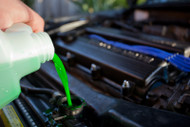Why Is There Oil In My Coolant?
17th Dec 2018

Do you have coolant in your engine oil? Or oil in your engine coolant? If so, this is a big problem that you should fix right away!
Have you discovered oil mixed with coolant in your car's radiator? If so, you’ve probably noticed a thick, milky, or gravy-like substance in and around your engine. That’s the telltale sign that there’s a problem. You don't have to be a professional auto mechanic to know that these fluids shouldn't mix together. Coolant stays in your cooling system while oil circulates through the crankcase and components. If your car's oil and coolant are mixing together, it’s usually a case of having a blown head gasket.
Why Oil and Coolant Mixing Together is a Problem
If there are only a few drops of oil in your coolant, you can probably still drive your car… at least for a while. If there are large amounts of oil in your coolant, continuing to drive could damage your engine. When large amounts of oil enter your cooling system, there's less oil to lubricate the engine. This causes the temperature gauge to go into the red zone. This causes serious engine problems.
A Blown Head Gasket is Usually the Reason
This is a common cause of oil mixing with coolant. This thin sheet of metal sits between the engine block and cylinder head. It creates an air-tight and liquid-tight seal. If it fails, oil and coolant may mix together. In some cases, coolant will enter the oil. In others, the oil will enter the coolant. When the head gasket fails, other symptoms occur. These include a loss of coolant or white smoke from your tailpipe.
Here are some of the problems that can happen when you don’t fix a blown head gasket:
1. Cracked Engine Block
Letting your car's engine overheat even just once can stress it enough to develop hairline cracks. Even if it’s small, those cracks allow oil and coolant to mix together. This results in that oily sludge showing up on top of your radiator. Since most cracked engine blocks require an entire replacement, it’s best not to ignore that blown head gasket.
2. Blown Connecting Rod
The connecting rod is an essential engine component. It serves as a link between the piston and the crankshaft. These rods undergo an extreme tensile force. They can give out under extreme heat and lack of lubrication from the coolant in the engine oil. If you have a blown connecting road, you’ll know it. If you’re driving slowly, you’ll hear a loud knocking under the hood. Driving between 6,000 and 8,000 RPMs will break the rod and destroy your engine.
How to Fix a Blown Head Gasket Without Replacing It
Buying a new head gasket can be expensive. Before doing that, try using a head gasket sealer. It can be a simple, easy solution that can save you a lot of money. Once you receive your head gasket sealer from us, here are the steps you’ll take to use it:
Remove your vehicle’s thermostat Flush the cooling system Fill the system with water Slowly add head gasket sealer to the radiator while your vehicle idles Install the radiator cap and let the engine idle for at least 50 minutes Drain the cooling system Install a new thermostat Fill the system with the correct amount of coolant.
If this doesn’t work, you’ll have to replace the head gasket entirely. This is a more complicated process that requires a lot of time, money, and plenty of tools to do the job.
JB Tools Can Help with Your Blown Head Gasket
We have the biggest selection of tools at the best prices. Most or all of the hand tools you need can be found in our inventory. This, plus our free shipping on most orders, makes us the best place to buy tools.

